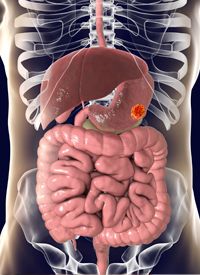Article
Bemarituzumab Plus Chemotherapy Significantly Improves Survival in FGFRb+ Gastric/GEJ Cancer
Author(s):
The addition of the first-in-class targeted therapy bemarituzumab to chemotherapy significantly improved progression-free survival and overall survival versus chemotherapy alone in the frontline treatment of patients with FGFRb-positive, locally advanced or metastatic gastric and gastroesophageal junction cancer.

The addition of the first-in-class targeted therapy bemarituzumab to chemotherapy significantly improved progression-free survival (PFS) and overall survival (OS) versus chemotherapy alone in the frontline treatment of patients with FGFRb-positive, locally advanced or metastatic gastric and gastroesophageal junction (GEJ) cancer, according to topline results from the phase 2 FIGHT trial (NCT03694522).
Topline results from the trial revealed that all 3 efficacy end points in the trial—PFS, OS, and overall response rate (ORR)—were found to achieve prespecified statistical significance at a 2-sided alpha of 0.20.
Specifically, the median PFS with bemarituzumab plus a chemotherapy regimen comprised of modified leucovorin calcium, 5-flourouracil, and oxaliplatin (mFOLFOX6) was 9.5 months versus 7.4 months with chemotherapy alone (HR, 0.68; 95% CI, 0.44-1.04; P =.073). Moreover, the median OS with the bemarituzumab/chemotherapy combination had not yet been reached compared with 12.9 months with chemotherapy alone (HR, 0.58; 95% CI, 0.35-0.95; P =.027). Notably, the addition of bemarituzumab improved the ORR by 13.1% (P =.106).
“These results bring us one step closer to the first potential targeted therapy for advanced gastric cancer in over a decade,” Helen Collins, MD, executive vice president and chief medical officer of Five Prime, stated in a press release. “Benefit was observed in patients whose tumors overexpressed FGFR2b, even without evidence of amplification, and that may broaden the therapeutic potential of bemarituzumab in more cancer types.”
Bemarituzumab is a targeted antibody that was developed to block fibroblast growth factors 10 and 22 from binding and stimulating FGFR2b, which hinders several downstream pathways. Investigators hypothesize that blocking this activation could slow progression of disease.
In the phase 2 trial, investigators examined the safety and efficacy of bemarituzumab in combination with mFOLFOX6 versus mFOLFOX6 plus placebo as frontline treatment in patients with newly diagnosed FGFRb-positive, locally advanced or metastatic gastric and GEJ cancer.
FGFR2b positivity was identified via immunohistochemistry and through the detection of FGFR2 gene amplification via circulating tumor DNA. A total of 155 patients spanning 15 countries were enrolled to the trial. To be eligible for participation, patients had to have histologically documented gastric or GEJ adenocarcinoma that is not amenable to curative treatment, an ECOG performance status of 0 or 1, and FGFRb overexpression. Patients had to have acceptable hematologic, liver, and kidney function.
If patients had untreated or symptomatic central nervous system metastases, significant cardiac disease, peripheral sensory neuropathy, an active infection in need of systemic therapy, human immunodeficiency virus infection, or active or chronic hepatitis B or C infection, they were determined to be ineligible. Patients who received previous treatment with a selective inhibitor of the FGF/FGFR pathway, had known HER2 positivity, or known abnormalities of the cornea, were also excluded from the trial.
The primary end point of FIGHT was PFS, while key secondary end points included OS, ORR, and incidence of treatment-emergent adverse effects (TEAEs).
With regard to safety, the frequency of all-grade toxicities proved to be comparable between the 2 treatment arms (100%, investigational arm vs 98.7%, control arm). The incidence of serious toxicities also proved to be similar in the bemarituzumab/mFOLFOX6 arm versus the mFOLFOX6 arm, at 31.6% versus 36.4%, respectively. Toxicities that resulted in death occurred in 6.6% of patients on the investigational arm versus 5.2% of patients on the control arm.
Toxicities that were grade 3 in severity proved to be more commonly experienced on the bemarituzumab/mFOLFOX6 arm versus the mFOLFOX6 arm, at 82.9% versus 74.0%, respectively. Specifically, corneal and stomatitis AEs were more frequently reported in the investigational arm. More patients in the investigational arm ended up discontinuing treatment due to toxicity compared with those on the control arm, at 34.2% versus 5.2%, respectively. Notably, retinal detachment or hyperphosphatemia were not experienced in the bemarituzumab/mFOLFOX6 arm.
“We have known for some time that FGFR is a viable target in gastric cancer and many other malignancies,” Zev A. Wainberg, MD, associate professor of medicine at UCLA, co-director of the Gastrointestinal Oncology Program, and director of Early Phase Clinical Research at the Jonsson Comprehensive Cancer Center, added in the release. “This is the first data to signal that a targeted therapy directed to FGFR2b may reduce the risk of disease progression and improve OS in gastric cancer. This study result showing bemarituzumab’s potential benefit is an important and exciting development.”
Five Prime Therapeutic Inc. reported that the full evaluation of the FIGHT finding will be conducted and they will be shared at an upcoming medical meeting.
Reference
- Five Prime announces bemarituzumab plus chemotherapy demonstrates significant progression-free and overall survival benefit compared to placebo plus chemotherapy in front-line advanced gastric and gastroesophageal junction cancer. News release. November 10, 2020. Accessed November 11, 2020. https://bit.ly/2Irzpfz.









